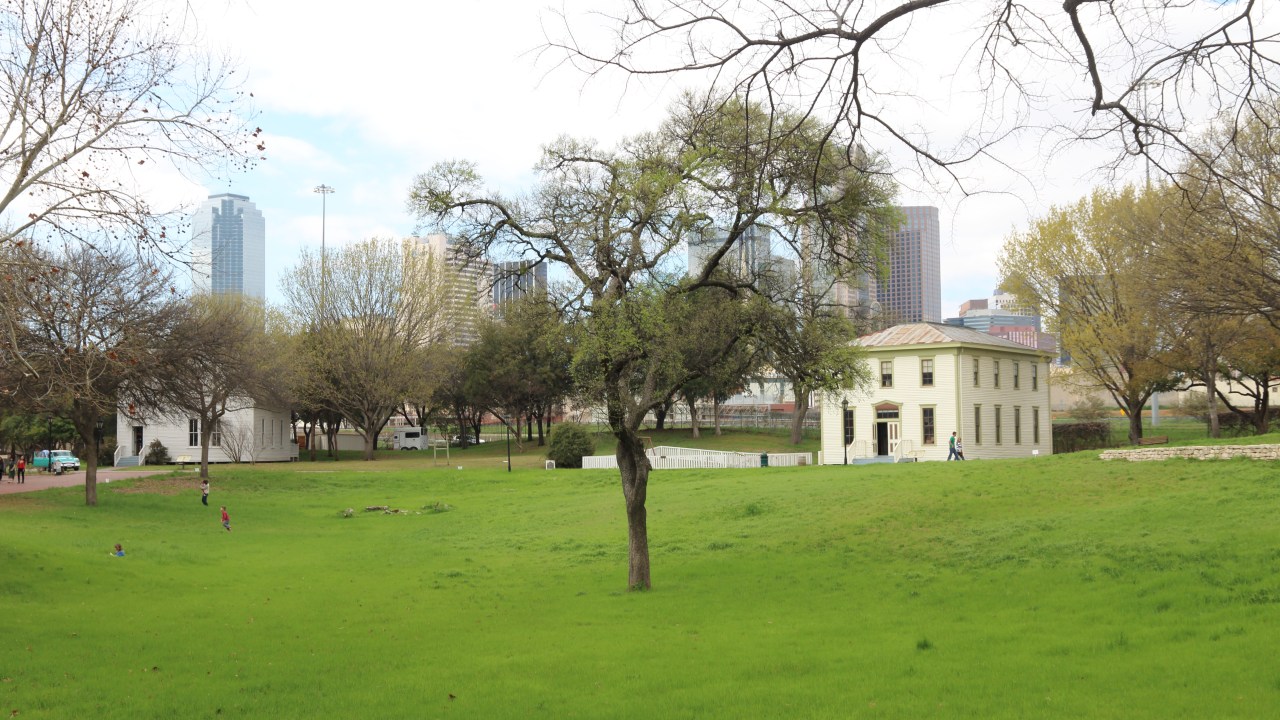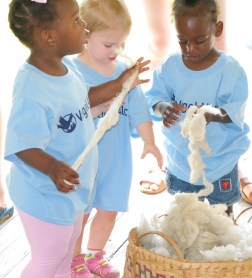
TrendsWatch 2019 draws attention to the rising rates of homelessness across the world, including the U.S., and profiles the work of several museums working specifically with and for people experiencing housing insecurity. But many museums, urban and rural, serve communities deeply affected by the housing crisis. Today on the blog, Melissa Prycer, president and CEO of Dallas Heritage Village, shares how her museum has worked with their diverse neighbors, including those who have no homes.
–Elizabeth Merritt, VP Strategic Foresight and Founding Director, Center for the Future of Museums
Sometimes a history museum has to confront present-day realities, even right outside its gates. This is the complicated situation Dallas Heritage Village (DHV) has operated in throughout its history. DHV is home to a collection of relocated historic structures, located in the historic Cedars neighborhood just south of downtown Dallas. The Cedars originally grew up around Dallas’ first city park and was always a diverse neighborhood, with a mix of housing for the wealthy and working class alike commingling with factories. But it fell on hard times after post-World War II white flight, and the construction of an interstate in 1965 effectively cut it off from the rest of downtown. Ever since, the neighborhood has struggled with poverty, crime, and homelessness.
A year after the construction of the interstate, in 1966, the Dallas County Heritage Society saved a plantation home called Millermore, and needed a place to relocate it. The society entered into a long-term agreement with the city to manage City Park and create a history museum that ultimately became Dallas Heritage Village. As long-time volunteers and former staff members report, the problems of the neighborhood continued around the museum, with everything from solicitation to arson happening beneath office windows. When I began working at DHV in 2004 as the program manager, the Cedars continued to have this reputation, though it was beginning to evolve as artists moved in.

Many social service agencies are located within a mile of the museum, and we have been able to work with some of them. Two of our closest neighbors are The Bridge, a homeless assistance center, and Vogel Alcove, which serves children experiencing homelessness. For years, we were the location for Vogel’s annual Easter egg hunt, and when they relocated to a site across the street from the museum, our partnership became something truly special. (You can read more about our work with Vogel on the CFM Blog and at Redeveloping History.) We also entered into a unique relationship with service provider The Stewpot’s job training program for homeless and at-risk individuals, hiring participants to assist with some of our maintenance projects.
Thus, when I became DHV’s executive director in 2014, both the institution and I had experience in working with organizations serving individuals experiencing homelessness to find possibilities that could benefit everyone. That experience and those relationships would prove invaluable when a homeless encampment developed directly behind DHV’s Farmstead property.
The large encampment began to form under the interstate in the summer of 2014, before some residents splintered off into the surrounding area, including along our back fence. The properties along our fence are owned by the Texas Department of Transportation, who had decided not to enforce trespassing laws, so for two years between fifteen and thirty people lived on them. Though they rarely came onto our grounds, their encampment had huge repercussions for our organization. We had several near misses with fire, including one instance when a tent near our schoolhouse burst into flames as a news crew was filming. Because of the perception that the museum was unsafe, our rental income dropped 40 percent, school tours dropped, and any number of potential visitors or members may have chosen not to visit or renew. Throughout this period, we worked as a staff and board to develop talking points for when visitors or community members expressed concerns (or complained.) First, we listened—and then we shared who we were working with to address the situation and how they could help. Through the entire encampment period, we consistently stressed that the issue wasn’t that people shouldn’t be living behind the Farmstead, but that no one should be living next to an interstate. Period. It wasn’t about DHV—it was about our entire community.
As we looked for a solution, much of my time, and my board’s time was spent on meetings with the Dallas Police Department, City Council, and neighborhood advocates. When the city developed a plan to close the larger encampment, known as Tent City, no plans were initially made for the smaller encampments located nearby, including ours. There were also no plans made to prevent other encampments from growing as they absorbed displaced individuals. Through advocacy efforts, the individuals living nearest DHV were ultimately included in the larger efforts to place them into housing or support programs. These efforts also resulted in some reorganizing at City Hall, creating a new Office Of Homeless Solutions that is attempting to unite all the city agencies and nonprofits that work with individuals experiencing homelessness. Progress in Dallas has been made, but there is still much work to do.
Though the encampment is gone, the homelessness issue is still very visible to all of our visitors. There is still a widespread perception that our neighborhood isn’t safe. Just last week, we discovered that someone has been coming over our fence at night to sleep at the farmstead and use the water fountain as a shower. This is not something that will be solved by anyone any time soon, and it only seems to be getting worse throughout the country. If there are echoes in our story with issues concerning your museum, here are some general thoughts:
- Build relationships with the social service nonprofits in your area that work with people experiencing homelessness. You will not be able to work with all of them, and it’s okay to make choices. At the most basic level, they will help you understand the complexities of homelessness, how changes in local politics may impact this population and any other nuances that may be left out of press coverage. As the relationship develops, you may discover programs or institutional partnerships that can benefit both your institution and the social service agency.
- Do your research. In my case, I began reading a lot more articles about homeless issues and the housing crisis in Dallas. As painful as it may be, I also recommend reading the comments on social media. It helped me learn what trigger words to avoid in any communications I made about the issue. It’s also a prime way to identify potential advocates—or people to be very careful around.
- Get to know your residential neighbors—and work with them. The Cedars Neighborhood Association is incredibly active and knows that it’s important to show up to meetings. However, they also realized that there are things that we can do as an institution that they can’t as residents. We worked together to get the needed meetings together and make sure our voices were heard. “The shift in the conversation about homelessness in the Cedars wouldn’t have been possible without us working together.” (https://redevelopinghistory.com/2016/05/02/more-answers/)
Finally, I do want to emphasize that this is difficult, intense work. Homelessness is a sensitive issue that requires a careful response. It’s also unusual territory for museum leadership and staff. I once commented to a reporter: “When I became a history museum director, I never dreamed that I would also become an expert on local homeless issues.” I’m happy to talk with anyone facing similar issues at their museum. In the end, museums must be good neighbors to everyone in their community, not just those with a healthy bank account and homes.








